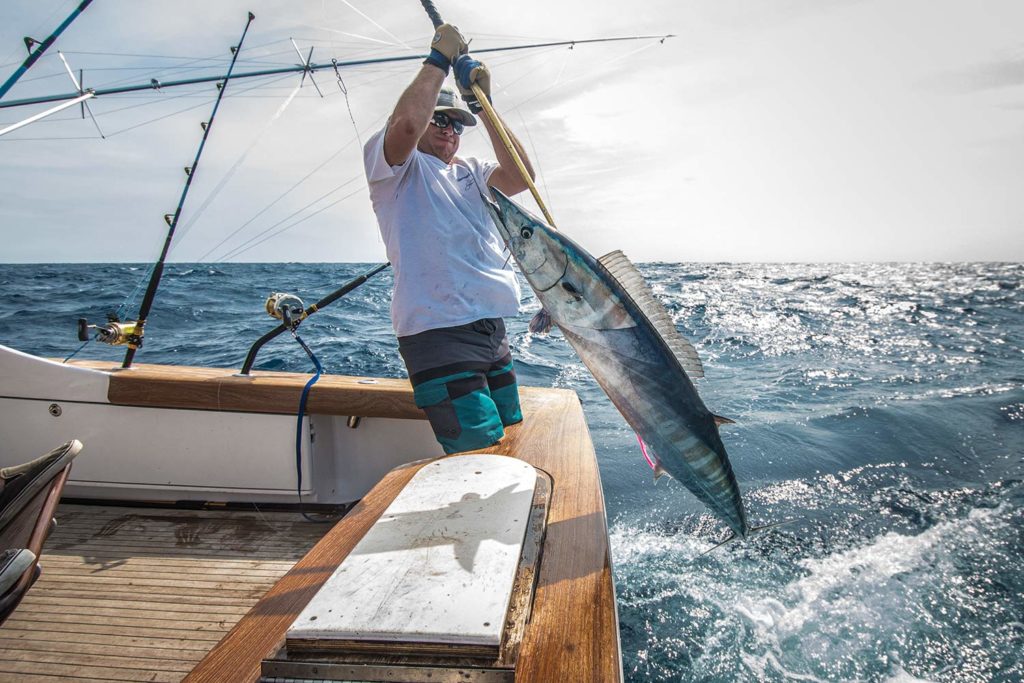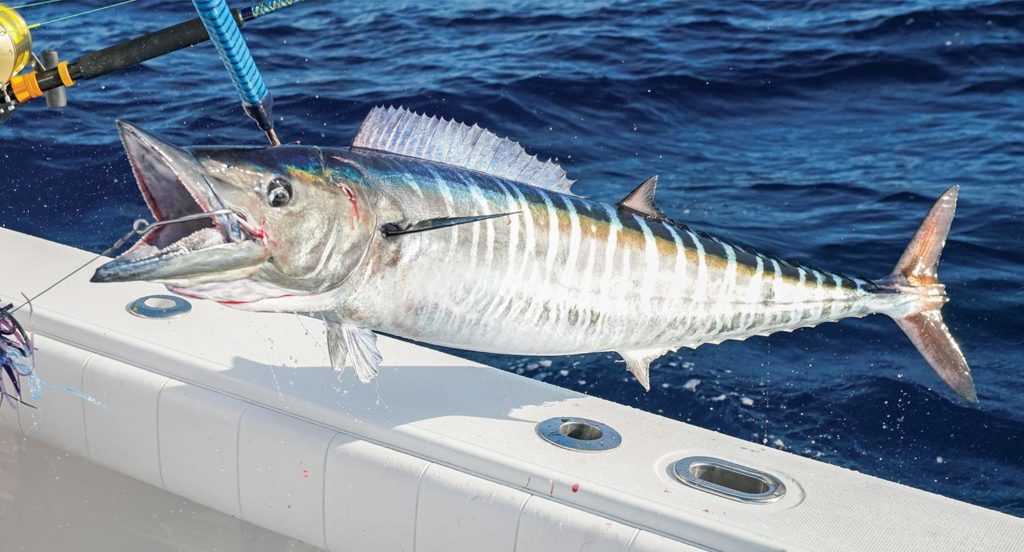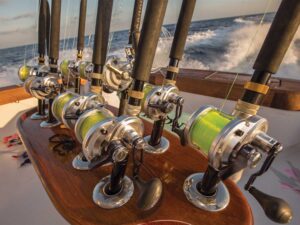
Special delivery: Sign up for the free Marlin email newsletter. Subscribe to Marlin magazine and get a year of highly collectible, keepsake editions – plus access to the digital edition and archives.
Wahoo are undoubtedly one of the fastest fish in the ocean, and their initial drag-screaming runs immediately after hookup make them an exhilarating gamefish to target. Wahoo can be found worldwide wherever the water is warm, and they tend to gather in water temperatures ranging between 72 and 80-plus degrees, and love to hang out on structure.
Whether it’s a wreck, hump, seamount, bank, ridge, drop-off, reef, weed line, or any other floating debris, wahoo typically hold tight to structure. Without fishing on some kind of structure or in the proper water temperature, your odds of catching wahoo are slim if not none.
There are many techniques used to catch these ocean speedsters, trolling being the most common. When talking about wahoo, nearly everyone immediately thinks about trolling fast. High-speed trolling at 12 to 18 knots is certainly effective, but trolling a mix of dead baits and artificial lures at 6 to 9 knots can also be successful and allow for more bycatch such as mahi, tuna, and even billfish.
Dead-Bait Trolling
My tactics prove that you don’t have to go fast to catch wahoo. Most of the wahoo I catch are when I’m trolling at dead-bait speed. Nearly all of my 100-plus-pounders were caught fishing with dead baits. This method has worked for me anywhere in the world I’ve tried it, consistently producing bites and catches of most gamefish species—depending on the location and season.
At these speeds, I am primarily pulling dead baits such as ballyhoo, mullet and belly-strip baits, all rigged with my skirt of choice. The downside? At times, barracuda will terrorize you when using this technique. This is truly the only downfall to slow-trolling for wahoo. However, if you and your crew can work through it, this technique will win over with a full fish box.
My typical wahoo spread consists of all wire-rigged baits with Nos. 9 and 10 wire. And my go-to bait is typically a heavy-head Ilander Flasher series lure rigged with a medium to large ballyhoo. I pull one shotgun, two long riggers, two short riggers, and two flat lines, which are my designated deep baits. The flats are dropped back just past the short riggers and sent down on planers off each transom cleat. If I have inline-planer setups or inline trolling weights, I will opt to use these with 50-wide bent-butt trolling outfits for each flat-line corner.
Baits Down
While surface baits do get bit by wahoo, oftentimes the baits that you get down in the water column have the most success. You can achieve this in many ways, from inline trolling weights to planers to downriggers to lipped diving plugs such as Rapalas, Nomads, Bombers and the like.
There are many ways to run planers, from the inline planer method that attaches the planer directly to your line via clips to running them straight from the cleat and attaching your line to them with a rubber band and sending them down. Some even use downriggers instead of planers, if they aren’t going to troll much faster than 6 or 7 knots. Basically, any way you can get some of your baits down in the water column is crucial to having a successful day of wahoo fishing. You can also get the baits down by pulling lipped diving plugs—just be sure you change out the hardware because the split rings and hooks they come with will fold on a nice wahoo. These lures do get bit if there isn’t a lot of weed around, and if they can be trolled at speeds of 5 to 8 knots.
Another way to get your baits down derives from the conventional high-speed trolling technique: utilizing an inline trolling weight. I prefer to use 48- to 64-ounce trolling leads and am always sure that both sides are outfitted with the same weight so that I never get tangled in a turn. The best way to set this up is with a 20-foot shock leader of 200- to 300-pound-test monofilament to a snap swivel that you can clip your bait or artificial lure to. This will ensure that your baits stay down in the water column at least by a few feet, and is also much more manageable when the surface weed is thick.

Using an inline trolling weight allows for more options when it comes to whether you prefer to pull an artificial wahoo lure or a dead bait because you don’t have to worry about a planer tripping or the rubber band or downrigger release clip popping. This is extremely helpful in areas where you get a lot of critter bites and need to mix in some artificial lures in your spread, especially down deep, where you can’t see if your bait’s tail has been nipped off.
I also use belly-strips in locations where we are getting a lot of barracuda or mackerel bites. Strip baits made from the bellies of tuna, wahoo, or mahi tend to hold up well and can handle a few more bites than a ballyhoo. I have had no problem getting bites from wahoo on belly strip baits, which saves you from blowing through your ballyhoo.
Read Next: Here’s the lowdown on winter wahoo fishing in the Bahamas.
Hooked Up
It’s extremely important to always keep forward momentum when you hook up a wahoo on the troll. Wahoo have hard mouths, and because of this, we can keep the drag tight on the bite to ensure a solid hookup, so 15 to 20 pounds of drag on the bite will really set the hook in the jaw nicely. Wahoo are masters of shaking out hooks if they can create any slack in the line, so you’ve got to keep them tight.
You must always remember that these toothy missiles have a gnarly row of razor-sharp teeth. I have seen their teeth do more damage than any other fish, and usually the injuries are to the flesh of those who are carelessly slinging them over the rail and onto the deck. Your situational awareness of these fish on the gaff is your first priority, and you will be far better off putting the fish directly in the box and leaving the rig in their mouths until they are ice-cold and no longer moving before you attempt to remove the hook.
Even though the basics of fishing technique change very little over time, fishermen still have the ability to experiment with different methods to (hopefully) produce better results. Slow-trolling for wahoo has worked for me, and I’m sure it will work for you too.







